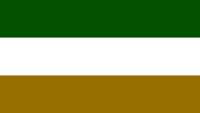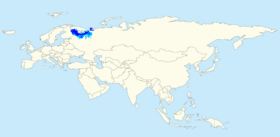Flewtish
This article is private. The author requests that you do not make changes to this project without approval. By all means, please help fix spelling, grammar and organisation problems, thank you. |
This article is a construction site. This project is currently undergoing significant construction and/or revamp. By all means, take a look around, thank you. |
| Flewtish | |
|---|---|
| Flũťa / Флӯтьа | |
 Flag of the Flewtish people. It is a simplified version of an ancient flag. The green represents nature, the white represents peace and the orange represents the joy to be alive. | |
| Pronunciation | [ɸlûːtʷa] |
| Created by | Aggelos Tselios |
| Date | 2023 |
| Native to | Russia, Finland |
| Native speakers | approx. 1 million (2023) |
Language Isolate
| |
| Official status | |
Official language in | Flewtish Autonomous Republic, Russia |
| Regulated by | Instituto Standarzabüro Flutadene Glung (Institute of Standardization of the Flewtish Language) |
Map of where Flewtish is spoken today. Dark blue areas indicate a majority Flewtish-speaking population, whereas light blue indicate areas where Flewtish is an important language. | |
Flewtish (endonym: Флутье [ɸlutʷe] or Флутье глун [ˈɸlutʷe ɡlun] ) is a language spoken in much of Northwest Russia and the Karelia region, as well as a large pocket in Eastern Finland. Flewtish is a language isolate, meaning it does not genetically relate to any other known language on the planet, similar to Basque in Europe.
Flewtish is a polysynthetic language, something uncommon for the Siberian or the European languages, hinting a distant Urheimat far away from today's Russia (Usually placed near the Mongolian border, see Proto-Flewtish). The language is split into 4 periods: Proto-Flewtish, Old Flewtish, Ḟlǔṫas Eṽétt (Modern Latin Orthography: Fluṫas Ewet), and Modern Flewtish, each one signified by the historical events accompanying them. It is a biscriptal language, using both the Latin and Cyrillic scripts to be written (In Finland and elsewhere respectively), although during the early medieval period there were Turkic writings too. An important aspect of the language is differentiating between labialized and non-labialized consonants (Referred in Flewtish as "rounded" and "unrounded") see eg. [kʷáɣ.op] "Warmth" and [káɣ.op] "Deer".
Flewtish is not one unified language. Rather, it is a large dialect continuum, stretching from Eastern Finland to the Ob river, and from the White Sea all the way to Bestozhevo (Arkhangelsk oblast), and the large distance between the dialects has caused the extreme ends of that territory to be completely unintelligible to each other.
Etymology and history
Flutwe is an evolution of Proto-Flewtish *pʰlutuɘp, meaning "Blooming" or "Saturated". The reason for this name is that the regions that Flewtish speakers settled were far more greener and developed than their previous homeland. Flewtish is possibly a Paleo-siberian language that through migration reached it's current territory. This can be further supported by similarities with the Yeniseian languages, like having a pitch accent, vowel harmony and vowel length distinction.
Following harsh winters in the area and raids from other local tribes, migrations westwards began in search of a better homeland. Eventually, after ~1000 years, Flewtish people decided to settle to modern day Arkhangelsk (Tanrikutt in Old Flewtish, lit. God's city) and the areas around, where their language would remain. Small pockets of their language that settled in the way during that migration period survived for a few more centuries before being assimilated to neighboring nations.
Flewtish, from it's early years, was influenced by Mongolic, Turkic and later Indo-European and Uralic languages. The most obvious example would be the large amount of Turkic and Finnic loanwords into Flewtish, but even titles from the states with Flewtish rule such as "Gǎngÿán [gâŋɢán]" (Leader, possibly related to Khagan), "Tãnrǐ [taːŋɾiː]" (Same origin as Tengri) and "Taerkáng [tɘɾ.káŋ] (Local ruler, related to Tarkhan). On the Indo-European side, the word "оўиг /ówyg/" (Sheep) is probably borrowed from the Proto-Indo-European word *h₂ówis (Or perhaps from Proto-Balto-Slavic) and the word "ғамеги" (milking, from PIE *h₂melǵ-).
Phonology
Sound in parentheses only appear in dialects. Labialized consonants are not included in this chart as they don't form separate phonemes.
Consonants
| Manner/Place | Bilabial | Labiodental | Dental | Alveolar | Palato-alveolar | Palatal | Velar | Uvular | Glottal |
|---|---|---|---|---|---|---|---|---|---|
| Nasal | m | n | (ɲ) | ŋ | |||||
| Stop | p b | t d | k g | (q ɢ) | (ʔ) | ||||
| Affricate | t͡s d͡z | t͡ʃ d͡ʒ | |||||||
| Fricative | f v | (θ) ð | s z | ʃ ʒ | x ɣ | (ʁ) | h | ||
| Approximant | w | j | |||||||
| Tap | ɾ | ||||||||
| Lateral approximant | l |
Vowels
| Front | Central | Back | |
|---|---|---|---|
| High | i y | (ɨ) | u (ɯ) |
| High-mid | e | (ɘ) | o |
| Low | a |
Orthography
Orthography and scripts
Cyrillic script
Flewtish is written from the 17th century onwards with a variation of the Cyrillic script, the Flewtish alphabet.
| Cyrillic Script for Flewtish | |||||||||||||||||||||||||||||||||
|---|---|---|---|---|---|---|---|---|---|---|---|---|---|---|---|---|---|---|---|---|---|---|---|---|---|---|---|---|---|---|---|---|---|
| Аа /a/ | Бб /b/ | Вв /v/ | Гг /g/ | Ғғ /ɣ/ | Дд /d/ | Ее /e/ | Ёё /ə/ | Зз /z/ | Ӟӟ /ð/ | Ии /i/ | Йй /j/ | Ўў /w/ | Кк /k/ | Лл /l/ | Мм /m/ | Нн /n/ | Оо /o/ | Ӧӧ - /jo/ | Пп /p/ | Рр /ɾ/ | Сс /s/ | Тт /t/ | Уу /u/ | Фф /ɸ/ | Ьь (ʷ) | Хх /x/ | Цц /t͡s/ | Чч /t͡ʃ/ | Шш /ʃ/ | Щщ /d͡z/ | Ыы /y/ | Юю /ju/ | Яя /ja/ |
The Flewtish alphabet also relies on acute accents to indicate that a vowel must be pronounced as a nasal one. The apostrophe may be used to show apheresis in rapid speech.
There are many dialects of Flewtish so the Flewtish alphabet is not reliable to denote the sounds of most dialects and accents. In that case, there are an additional 5 graphemes used to denote sounds found in the most spoken non-standard accents, eg. the one in Ukhta.
- Ӱӱ - /ɯ/
- Өө - /θ/
- Ъъ - /ʔ/
- Ӈӈ - /ŋ/*
- Іі - /ɨ/
Latin script
Flewtish was written for a large period using the Latin script, adopted from contact with Germanic peoples in the west. Although it is rarely used since the late 20th century, it can still be found in inscriptions. It also survives as part of the dialect spoken in Eastern Finland.
Turkic script
Finally, dialects of Flewtish were written during the Old Flewtish period (452CE-778CE) using the Turkic script, while the southeastern tribes were subjugates by Turkish khanagates. Few inscriptions survive to this day.
Grammar
Flewtish is a polysynthetic language, using circumfixes or other affixes to change word meaning, or show different grammatical functions. Some dialects tend towards a more moderate, agglutinative model (By using fewer morphemes per word than other dialects), however the principle of affixation is shared between all dialects.
In addition, Flewtish contains an animate-inanimate distinction. If any part of speech within a sentence is animate, the subject, object and verb must take the -ü suffix.
Nouns
There are 10 cases (12 if dialectal ones are included) in Flewtish, formed usually with the use of an affix (For example: The apple: Hetceńe, I ate the apple: Wo jepgo hetceńen), with the exception of the nominative case which doesn't need any inflection directly. The exact suffixes can be found below, in the "Cases" section.
Similarly, possession is shown with a suffix.
| Suffix | Rough English Translation | Example |
|---|---|---|
| -mno | Mine | hetsjeńemno |
| -ði | Your | hetsjeńedi |
| -muk | His/Hers/Its | hetceńemuk |
| ne-, -mno | Our | nehetsjeńemno |
| ne-, -sji | Your (plural) | nehetsjeńesji |
| ne- -ktu | Their | nehetsjeńektu |
Flewtish doesn't have articles, but uses the -e suffix as a replacement for the definite article, and sal for the indefinite article.
Adjectives
Adjectives in Flewtish have three degrees (Positive: crasnī, Comparative: cakrasnī and Superlative: crasnītta), which correspond roughly to the English and German suffixes -er and -est. They lack a plural number and they are always used in their singular form.
Word order
Flewtish is strictly an SVO language, except in answers, where the SOV form is used instead. Like most European languages, it uses word intonation to show emphasis.
Pronouns
Flewtish contains the usual three pronouns, with a distinction on the third person pronouns for animate and inanimate objects. Flewtish does not use standalone pronouns often, resorting instead to suffixes on the root verb.
| English | Flewtish |
|---|---|
| I | Ғен |
| You | Ðи |
| (He or she)/it | У/Шов |
| We | Неғен |
| You (pl.) | Неши |
| They | Увок(ы) |
Cases
Flewtish has 10 cases, most of which correspond to English prepositions. Depending on the dialect, the number or the actual inflection of the cases may vary significantly (The easternmost dialects spoken in Finland for example preserved the ancient attributive case whereas all other dialects eventually lost it).
| Case | Affix | Example | English Approximation | Notes |
|---|---|---|---|---|
| Nominative | (None) | House | - | |
| Genitive | -den | Dõmmaden | Of the house | - |
| Accusative | -n | Dõmman | The house | The accusative is formed when an action is done upon the object. |
| Vocative | -e | (Ē) Dõmmae | (Hey) house! | Dialectal only, conflicts with suffix -e (Similar to English 'the') |
| Adessive | -je | Dõmmaje | At the house | Dialectal only, usually fused with the inessive |
| Inessive | -seg | Dõmmaseg | In the house | Also exists as e-root-sek |
| Ablative | -sje | Dõmmasje | From the house | - |
| Essive | -l | Ēne Dõmmal | As a house | Rare, now usually the Russian borrowing 'как' is used. |
| Translative | -se | Dõmmase | (Transformed) into a house | |
| Instrumental | -om | Dõmmaom | With a house | If it conflicts with the accusative, then it becomes -on |
| Causal-Final | -d | Dommad | For the house | - |
| Comitative | k-, -to | Kodommato | With (the company of) the house | Often fused with the instrumental. |
Basic Vocabulary
Numbers
| Number | English | Flewtish |
|---|---|---|
| 0 | Zero | Нул |
| 1 | One | Зааԓ |
| 2 | Two | Деюе |
| 3 | Three | Заш |
| 4 | Four | Нóюе |
| 5 | Five | Аўе |
| 6 | Six | Еўе |
| 7 | Seven | Юскы̄ |
| 8 | Eight | Анá |
| 9 | Nine | Цьербус |
| 10 | Ten | Ԓе |
Sample text
Article 1 of the Universal Declaration of Human Rights
English: All human beings are born free and equal in dignity and rights. They are endowed with reason and conscience and should act towards one another in a spirit of brotherhood.
Flewtish (Latin): Awel neemól zalpen nesvabodii ve tiğez ivoam ve prava. Nežewemeg šiwatak ve sosnanije ve nekareveljomeg zaal baknwékonjoamd.
Flewtish (Cyrillic): Аўел неемóл залпен несвабoдии ве тиғез ивoам ве права. Нежеўемег шиўатак ве соснанийе ве некаревелйомег заал бакньéконйоамд.


